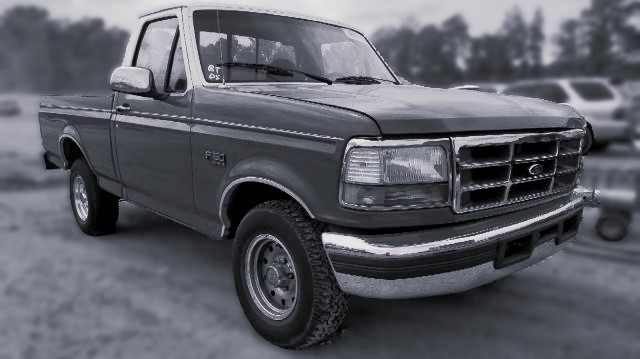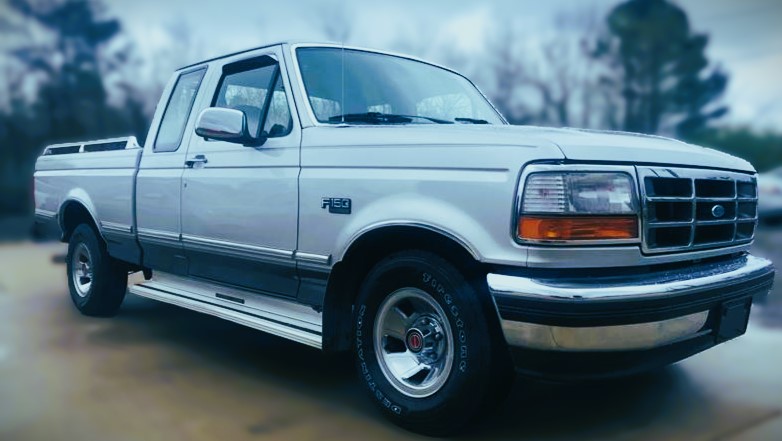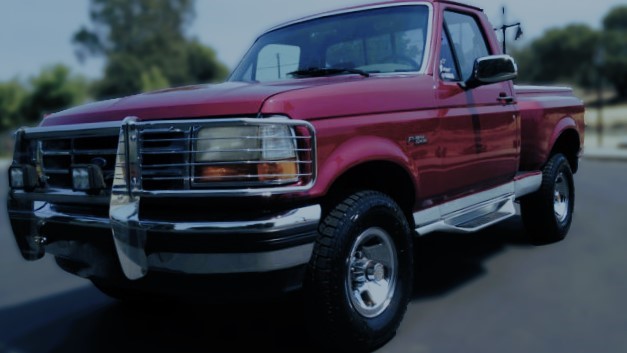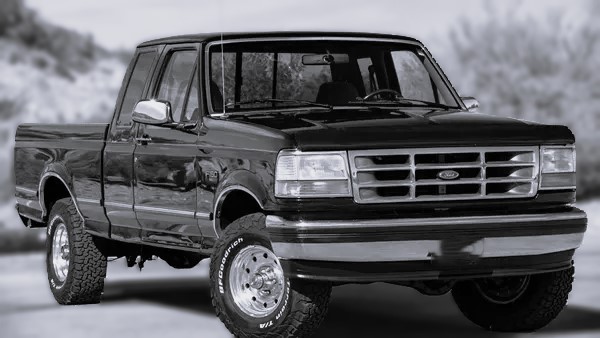
Guys, remember the ’90s? Grunge music blasting from your Discman, neon colors, those oversized jeans… it was an era of questionable fashion but undeniable energy! The same holds true for the trucks of the time, and the 1993 Ford f150 is pure ’90s nostalgia on wheels. Its boxy shape and no-nonsense attitude were a staple of job sites and dusty backroads across America.
But why focus on 1993 specifically? This wasn’t just another f150 model year. It marked a turning point. ’93 was the final year of Ford’s classic square-body truck design, a style that had been a workhorse favorite since 1980. The following year, Ford went all-in on modern curves and softer lines. For some, those old-school f150s represent the end of a truly rugged era.
So, who finds the 1993 f150 irresistible today? There’s something for a surprising range of truck enthusiasts:
- The Nostalgia Buff: Maybe you owned one back in the day, hauling dirt bikes to the track or cruising with your buddies. The ’93 f150 brings all those memories flooding back.
- The Anti-Tech Trucker: If the touchscreens, lane-keeping assists, and countless beeps of modern trucks make you roll your eyes, the ’93 f150’s basic controls and lack of electronic nannies might be a breath of fresh air.
- The Project Truck Enthusiast: You crave a blank canvas for your automotive dreams. The ’93 f150 is perfect for a ground-up restoration, a wild custom creation, or even just a reliable beater that needs some elbow grease to run right.
- The History Lover: Trucks aren’t just transportation; they’re a slice of American culture. The 1993 f150 holds its own place in automotive history as the end of an iconic generation.
This blog post is a deep dive into the world of the ’93 Ford f150. We’ll cover its strengths, its weaknesses, what to look for when buying one, and whether it’s the right truck for you in the 21st century!
The Basics: What Was the 1993 Ford f150?

The 1993 Ford f150 marked the end of an era. While its boxy design might look straightforward, underneath there were a surprising number of choices buyers could make. Understanding these options is crucial if you’re hunting down a ’93 f150 today, as it could mean the difference between finding your perfect vintage truck and ending up with one completely unsuited to your needs.
Let’s break down the key things you need to know about what makes a 1993 Ford f150 tick:
Engine Options: Under the hood, the 1993 f150 provided choices to suit different needs and budgets:
- Engine Options: Under the hood, the 1993 f150 provided choices to suit different needs and budgets:
- The Workhorse: A 4.9L inline-6 was the standard engine. Known for basic reliability and decent fuel economy (for the era), it was perfect for hauling around town, light-duty jobs, or as a foundation for a powerful engine swap in a project truck.
- V8 Power: If you needed more grunt, several V8 options were available, including the 5.0L and the larger 5.8L. These delivered significantly more towing capacity and stronger acceleration. If speed was on your wish list or hauling heavy loads was a regular task, a V8 was the way to go.
- Fuel Economy Note: Don’t expect miracles. These trucks are old-school, and even the smallest engine won’t compete with modern truck mileage. Factor potential fuel costs into your ownership budget.
- Trim Levels: The 1993 f150 came in a few main flavors, along with some special editions, letting you choose how basic or well-equipped you wanted your truck:
- XL: The no-frills workhorse. Vinyl seats, basic radio, manual everything – built for job sites, not long road trips. This is where you might find a manual transmission and the most budget-friendly used examples.
- XLT: Added creature comforts like cloth seats, power windows, nicer upholstery, and the option for more powerful engines. A popular choice balancing features and price.
- Custom/Eddie Bauer: For those wanting more luxury, these higher trims offered leather, cassette players (cutting-edge in ’93!), and unique styling touches.
- Special Editions: Keep an eye out for trims like the Nite edition with unique blacked-out styling or regional variations, offering special packages and features. These can be collectible.
Transmissions & 4X4: Gearing Up For Your Needs
Shifting Choices: Most 1993 f150s had automatic transmissions for easy driving, but 5-speed manuals were available (often on XL models) for those who prefer full control or maximum reliability for hard use.
2WD vs. 4WD: Two-wheel-drive was standard but for tackling anything off-road, 4×4 could be added as an option across most trim levels. Consider how much off-road capability you honestly need to avoid paying for a feature you’ll rarely use.
Transfer Case Options: 4×4 f150s offered either a manually shifted transfer case (maximum durability for serious off-roading) or an electronic shift-on-the-fly option (more convenient, better for occasional rough terrain).
1993 Ford f150: Strengths and Weaknesses
Reliability Spotlight: Let’s get real – these trucks are pushing 30 years old. Time and the elements take their toll, so expect some things to need fixing. Here’s where 1993 f150s often show their age:
- Rust: The number one enemy, especially if the truck lived in a harsh climate. Inspect the frame, cab corners, bed floor, and basically any metal surface meticulously before you buy. Even minor rust can hide major structural damage.
- Electrical Gremlins: Wiring gets brittle over time, leading to frustrating issues with lights, power accessories, and even odd engine running problems. Be prepared to diagnose and fix these quirks.
- Worn-out Suspension: Bushings dry rot, shocks leak, and the ride quality goes from basic to bone-jarring. Refresh the suspension if you intend to drive it regularly.
- Engine-Specific Issues: Each of the available engines has known trouble spots. The 5.0L can develop head gasket problems, the 5.8L can be prone to intake leaks… doing your research before falling in love with a specific truck is vital.
- “The Little Stuff”: Expect broken interior trim, leaky seals, and parts that just fail due to age. It comes with the territory!
The Good: Despite the issues, people still adore these old Fords for good reasons:
- Mechanical Simplicity: For DIY enthusiasts, these trucks are a dream compared to modern ones. Under the hood, there are no complex electronics to fail, giving you the confidence to tackle most repairs and upgrades.
- Parts Availability: While some things get rare, essential parts for basic maintenance are still plentiful and often shockingly affordable compared to modern trucks. Aftermarket support remains surprisingly strong too.
- Built Tough (Mostly): The bones of these trucks are solid, meaning the frame and major drivetrain components can often withstand serious abuse if they haven’t been ruined by rust.
- That Classic Feel: There’s something undeniably satisfying about driving a vintage truck. From the heavy feel of its steering to the lack of modern beeping distractions, it’s a driving experience from a bygone era.
The Bad: It’s not all sunshine and nostalgia. Here’s the less-pleasant reality of owning a truck this old:
- Creature Comforts: They don’t exist compared to what we’re used to. Even a basic modern truck will feel luxurious after time behind the wheel of a ’93.
- Safety Shortcomings: No airbags, basic seat belts, and a body structure designed decades ago. Driving defensively and with extra awareness is essential.
- The Hunt for Perfection: Finding a clean, rust-free, well-maintained ’93 f150 takes patience and often, a willingness to travel for the right truck.
- Constant Tinkering: Something small will always need attention. Get used to weekends spent under the hood or under the truck!
- The “Worth It?” Factor: This is personal and depends on your goals and expectations:
Am I Handy?: DIY skills turn a potential money pit into an enjoyable (if sometimes frustrating) automotive adventure. Paying a mechanic gets expensive on a truck this age.
- What’s My Goal?: If you need a reliable daily driver, look elsewhere. But as a project truck, weekend toy, or to relive ’90s nostalgia, it could be perfect.
- What’s the Budget?: Set a realistic spending limit BEFORE you start shopping, and factor in unexpected repair costs. These trucks have a way of draining your wallet faster than you’d expect.
Who Should (and Shouldn’t) Buy a 1993 Ford f150

Let’s be brutally honest: a 1993 Ford f150 is the WRONG truck for many people. Understanding who fits these trucks (and who doesn’t) will save you a whole lot of headaches and cash further down the line.
NOT a Daily Driver… For Most People
If your primary need is reliable transportation to get to work, haul the kids around, and run daily errands, the 1993 f150 is a risky bet. Here’s why:
- Reliability: Even a well-preserved example will likely need more frequent repairs than a modern vehicle. Breakdowns happen, and they can leave you stranded.
- Fuel Cost: These old trucks are thirsty, especially the V8s. With gas prices fluctuating, you might find yourself at the pump more often than you’d like.
- Safety: They lack airbags, anti-lock brakes, modern crumple zones, and basically all the safety tech we take for granted. You have to be an extra cautious driver.
- Creature Comforts: These are WORK trucks from a different time. Expect stiff seats, a noisy ride, and the kind of basic interior that makes “entry-level” modern trucks feel like the lap of luxury.
The Project Truck Crowd: Your Perfect Match
Do you love getting your hands dirty? Enjoy the satisfaction of bringing something old and neglected back to life? Dream of customizing a truck from the ground up? Then the 1993 f150 could be an amazing blank canvas.
- Simplicity = DIY Heaven: No complex computers or electronics to wrestle with. These trucks are built in a way most home mechanics can understand and fix themselves.
- Parts Galore: The aftermarket for these trucks is huge – everything from basic maintenance parts to crazy performance upgrades are widely available.
- Potential for Awesomeness: Restomod a classic f150 with modern brakes, suspension, and even an engine swap… you’re only limited by your budget and imagination.
The Nostalgic Weekend Cruiser: Proceed with Caution
Maybe you want to relive that 90s feeling, cruise with the windows down, and turn heads with a classic truck. The 1993 f150 CAN work, but only if you go in with eyes wide open:
- Find the BEST One You Can: A rusty, worn-out f150 will turn your nostalgia trip into a repair nightmare. Be patient in your search and choose condition over price.
- Upkeep Still Matters: Even for light use, you need to budget for basic maintenance. These trucks don’t like sitting for long periods and need regular care.
- “Weekend Only” Mentality: Is it REALLY going to be a weekend hobby truck? Be honest with yourself, as the temptation to daily drive it will be strong.
- “Cheap Truck” Trap: Beware the Bargain
It’s tempting to think you can snag a 1993 f150 for dirt cheap and have reliable wheels. This mindset is a recipe for costly disaster. Here’s the harsh truth:
- “Cheap” = Needs Work: A low price likely means neglected maintenance, hidden rust, or major issues the seller is hiding.
- The Cost Spiral: Cheap truck + expensive repairs = A hole in your wallet. Factor repair costs into the REAL price of ownership.
- Budget Accordingly: If you’re pinched for cash, ANY older vehicle is risky. Save up more or consider a newer, cheaper base-model truck for true reliability.
The Bottom Line: Is a 1993 Ford f150 Right for YOU?
The decision of whether to buy a 1993 Ford f150 ultimately boils down to a mix of practicality and passion. If you prioritize a trouble-free ownership experience, need modern safety features, and cringe at the thought of getting under the hood on a regular basis, this vintage truck is going to cause you more frustration than joy.
But, if you possess mechanical know-how (or have a burning desire to learn!), dream of building something unique, or yearn for that pure old-school truck experience, a 1993 f150 could be the start of a long and satisfying automotive relationship.
Before taking the plunge, answer a few key questions with brutal honesty:
- Why THIS Truck?: Are you drawn to its looks, its simplicity, or something else?
- Budget vs. Expectations: What can you realistically afford to buy, fix, and maintain?
- Your True Needs: Is this a toy or are you relying on it for daily transportation?
There’s no single right answer as to who should buy one of these classic Ford trucks. But with realistic expectations, careful research, and a good dose of DIY spirit (or a trustworthy mechanic on speed dial), owning a 1993 f150 can be an adventure you won’t regret.
The 1993 f150 SVT Lightning: A Special Beast
While the standard 1993 f150 range was about work (with varying levels of creature comforts), the SVT Lightning was a different animal entirely. Ford’s answer to the rising popularity of sport trucks, this wasn’t your grandpa’s farm truck, but a performance machine that just happened to have a bed. Today, it retains a loyal following and holds a unique place in automotive history.
What Made It Stand Out:
Performance Pedigree: The heart of the Lightning was a heavily modified version of the 5.8L V8 lifted from the Mustang GT and tuned for truck duty. With 240 horsepower and 340 lb-ft of torque, it had the grunt to back up its aggressive appearance. This level of power was practically unheard of in a production truck back in 1993.
Street-Truck Attitude: This wasn’t about hauling loads; it was about dominating the pavement. Unique bodywork, a lowered stance, and those instantly recognizable 17-inch wheels broadcast the Lightning’s intent the moment you saw it.
More Than Just a Dressed-Up f150: Ford’s Special Vehicle Team (SVT) backed up the Lightning’s looks with substance. They reinforced the frame, fitted it with a heavy-duty transmission, upgraded its brakes, and added a limited-slip differential to put its power to the ground effectively.
Built for Enthusiasts: From its lightning bolt embroidered sport seats to its special badging, the Lightning was a truck designed for enthusiasts who wanted something different from the endless sea of work-focused pickups.
Rarity and Price:
Even when new, the f150 SVT Lightning was a rare beast. Production numbers were low, and finding one that hasn’t been abused or heavily modified is a challenge. This limited supply, combined with its historical significance, has a major effect on its value:
Collector Appeal: The Lightning’s potent mix of performance, ’90s nostalgia, and rarity make it a highly desirable truck for Ford enthusiasts and those seeking unique performance machines from the era.
Don’t Expect a Bargain: Be prepared to open your wallet. A clean, low-mileage Lightning will cost significantly more than even the nicest regular f150 from 1993. You’re paying for that exclusivity and a piece of Ford’s performance truck history.
Worth It? As with any collector vehicle, this depends on your priorities and budget. If having a unique, surprisingly fast truck from an iconic era is your dream, and you’re willing to pay for it, the Lightning could be the perfect addition to your garage.
Absolutely! Here’s a detailed look at buying and owning a ’93 f150, aiming for that 900-word count and incorporating the practical advice potential owners need to make smart decisions:
Finding, Buying, and Owning a 1993 f150
The Hunt is On: Where to Look
Unlike buying a new car from a dealer, finding a decent 1993 f150 requires searching the right places:
- Online Classifieds: The usual suspects (Craigslist, Facebook Marketplace, etc.) will turn up listings, but be prepared to sift through junk to find the occasional gem.
- Specialty Forums: Join forums focused on the generation of f150 or 1990s Ford trucks. Owners often list them for sale, and enthusiasts might know of trucks not advertised publicly.
- Classic Truck Dealerships: Some dealers specialize in older vehicles. Expect to pay more than a private seller, but these trucks may come with some prep work done.
- Word of Mouth: In rural areas, still one of the best ways to find old trucks is by asking around. That f150 parked for years might be for sale if you know the owner.
Pricing: A Moving Target
It’s difficult to provide exact price ranges, as values fluctuate based on location, condition, and how badly the seller wants it gone. However, here’s a rough idea of what you might encounter:
- The “Might Run” Specials: Think $1000 -$3000 range. Expect heavy rust, possible major mechanical issues, or a “project abandoned mid-way” situation. Only for the brave and mechanically skilled.
- The Decent Driver: $4000 -$8000 is where you’ll find trucks with reasonable mileage, minor rust (hopefully), that run reliably, but likely need some TLC.
- The Clean Examples: For really nice, low-mileage f150s, especially desirable trims (XLT, 4×4) be ready to spend upwards of $10,000, sometimes much more.
- SVT Lightning Territory: These are collector vehicles with prices to match their rarity. Expect to spend far more than on any regular f150 from the era.
Pre-Purchase Inspection is NON-NEGOTIABLE
Found an f150 that piques your interest? Even if you’re an experienced mechanic, paying for a professional inspection is the smartest way to avoid buying a nightmare disguised as a vintage truck.
- Find the Right Shop: Look for a shop that specializes in older vehicles or specifically classic Ford trucks. They’ll know exactly where these trucks hide their problems.
- The Cost is Worth It: A pre-purchase inspection may run you $100-$300, but it’s the cheapest insurance you’ll ever buy compared to fixing major issues you missed.
- Common Rust Zones: Know Where to Look
Rust is Enemy #1 when buying a 1993 f150. Here are the key areas to scrutinize (photos would be ideal if you’d like me to add some!):- Frame: The backbone of the truck. Serious frame rust renders it unsafe and nearly impossible to fix properly.
- Cab Corners and Rocker Panels: These rot from the inside out. Minor bubbling often means there’s extensive internal rust.
- Floor Pans: Especially in trucks that sat unused for a long time, trapping moisture inside the cab.
- Wheel Arches and Bed: Common rust areas, and while less serious structurally, expensive to repair correctly.
- “Everywhere Else”: These trucks are prone to rust. Check around door hinges, seams, and under moldings.
Parts Availability: The Good, the Bad, and the NLA
The huge aftermarket industry for these trucks helps, but reality is, some parts are getting scarce:
- The Good News: Basic maintenance items (filters, brake parts, tune-up items, even many suspension components) are readily available and surprisingly affordable.
- The Ehh News: Engine internals, body panels, and certain trim pieces get pricier and require more hunting. Expect to use online forums, junkyard searches, and possibly pay steep prices for some of those rarer parts.
- The NLA: “No Longer Available” from Ford means relying on the used market, reproductions that aren’t always great quality, or having parts custom fabricated (read: expensive).
Building a 1993 f150: The Possibilities

One of the greatest things about owning a 1993 f150 is the sheer potential to customize it into the truck of your dreams. Whether you crave a show-stopping restomod or just want a reliable classic to cruise around in, there’s a path for you.
Restomod Trend: The Best of Both Worlds
Restomods blend that classic truck look with modern performance and reliability. Think disc brake upgrades tucked behind vintage-style wheels, a fuel-injected engine swap for power and easier maintenance, or a modern air conditioning system hidden out of sight.
- Skill and Budget Demanding: Restomods are awesome but require a blend of fabrication skills (or the cash to pay someone who has those skills!) Parts for newer vehicles aren’t always a direct fit in an older truck.
- The Payoff: When done well, a restomod is an amazing machine, but don’t expect it to be cheap or quick to build.
Budget Builds: Big Impact, Smaller Bills
Not everyone wants (or can afford) a wild restomod. Luckily, there’s plenty you can do to improve your f150 without emptying your bank account:
- Focus on the Basics: New fluids, a proper tune-up, replacing worn suspension bushings… these transform the driving experience without costing a fortune.
- Junkyard Gems: Scoping out salvage yards can score you upgrades like nicer seats from a different trim, or newer Ford parts that bolt onto your truck.
- DIY Savings: Labor is the most expensive part of any build. If you’re willing to learn, you can save major cash – online forums are your friend!
Should You DIY? Honesty is Key
The DIY route offers huge savings and satisfaction, but know your limits:
- Skill Assessment: Be realistic about your current wrenching abilities and your willingness to learn new things as problems pop up.
- Tool Time: Do you have the basic tools? More specialized tasks (transmission rebuilds, etc.) require specialized equipment you might not own.
- When to Call a Pro: Some jobs are best left to the professionals – things like major body repair or wiring harness work. Get quotes before starting something in over your head.
- The Hybrid Approach: It’s okay to do SOME things yourself to save money, and outsource the complex tasks. There’s no shame in that!
The Verdict
The 1993 Ford f150 isn’t a truck for everyone. It’s old, lacks modern conveniences, and demands ongoing attention in a way new vehicles simply don’t. From battling rust to chasing down replacement parts, there will be moments you question your sanity.
But here’s the thing: for the right person, all those “cons” are actually part of the 1993 f150’s unique charm. There’s a satisfaction in fixing things yourself, in the sound of that classic V8 rumbling to life, and turning heads in a truck that stands out from the crowd of cookie-cutter modern pickups.
The joy of ownership lies in the EXPERIENCE. It’s about cruising slow on a summer evening, tinkering on weekends, and being part of a community of enthusiasts who appreciate these trucks just as they are. It’s more than just transportation; it’s a connection to a piece of 90s automotive nostalgia and that timeless appeal of truly rugged, simple machines.
So, should you buy a 1993 f150? There’s no easy answer. If you have the mechanical aptitude (or the desire to learn!), realistic expectations, and a budget for the inevitable repairs, it could be incredibly rewarding. But if you need worry-free driving and the latest tech, look at a younger truck. Ultimately, if the idea of owning a 1993 Ford f150 sparks a sense of excitement, then don’t ignore it – there’s a good chance it might just be the perfect classic truck for you.